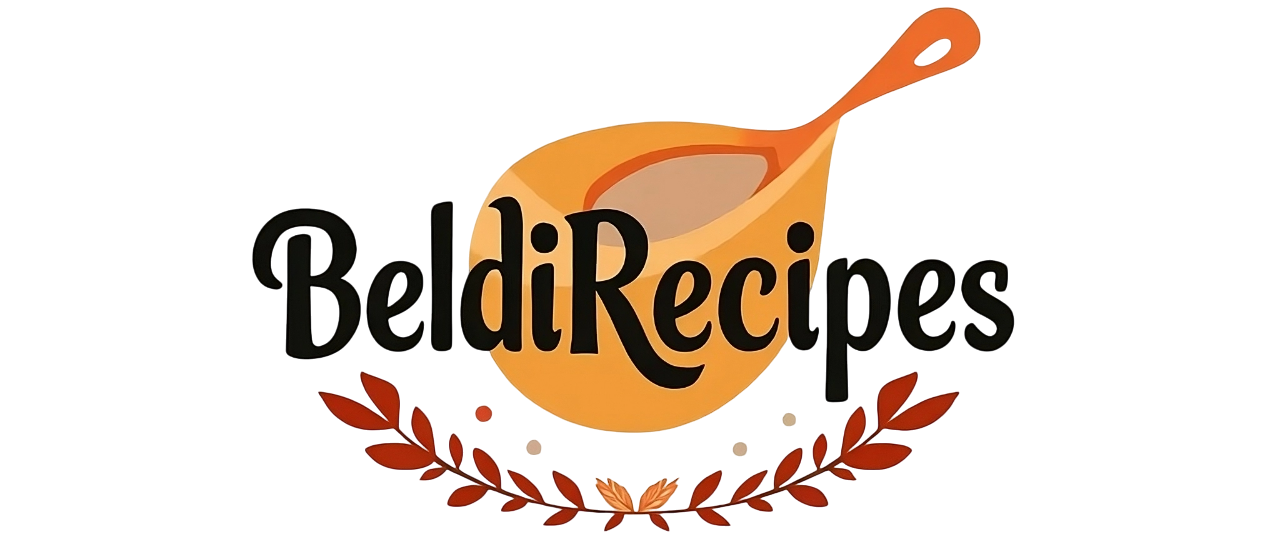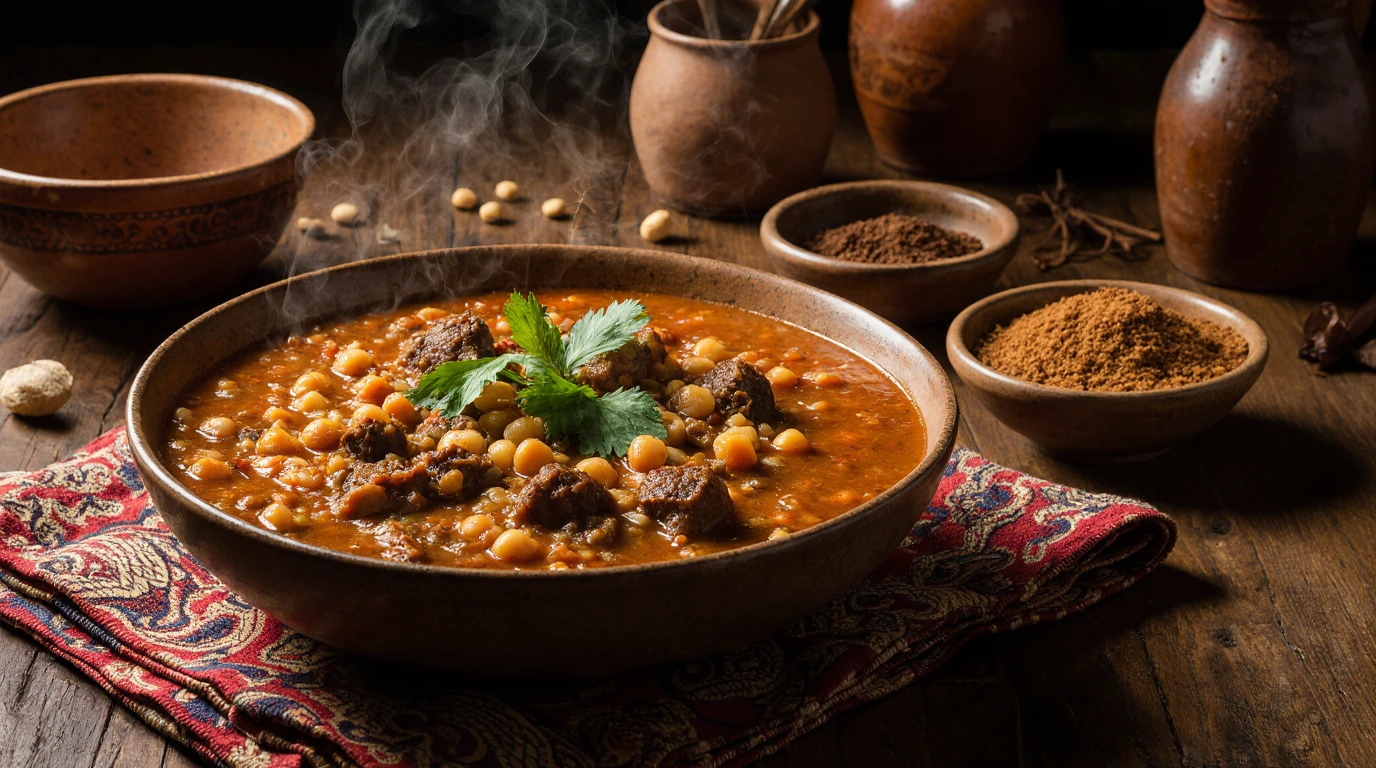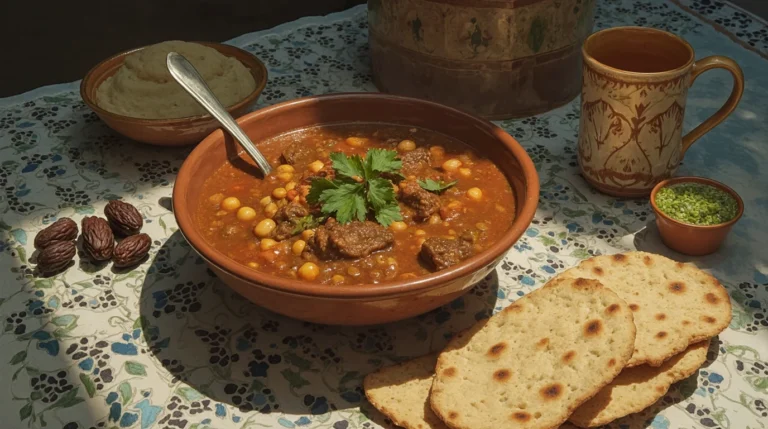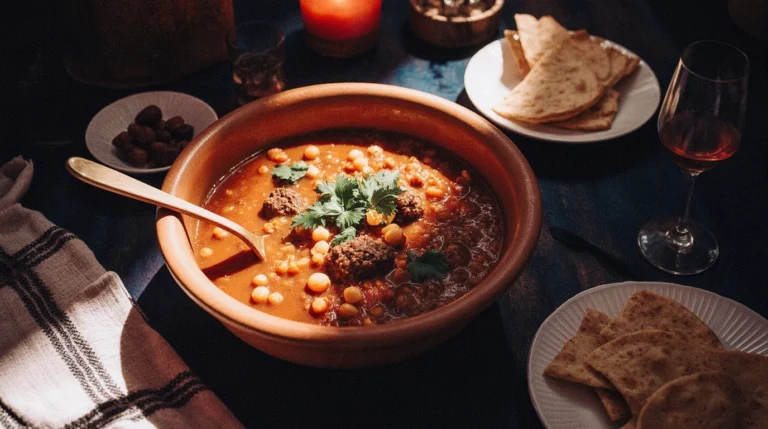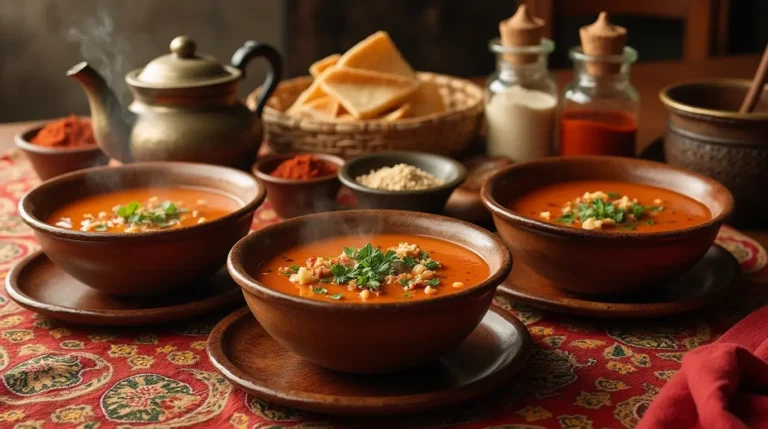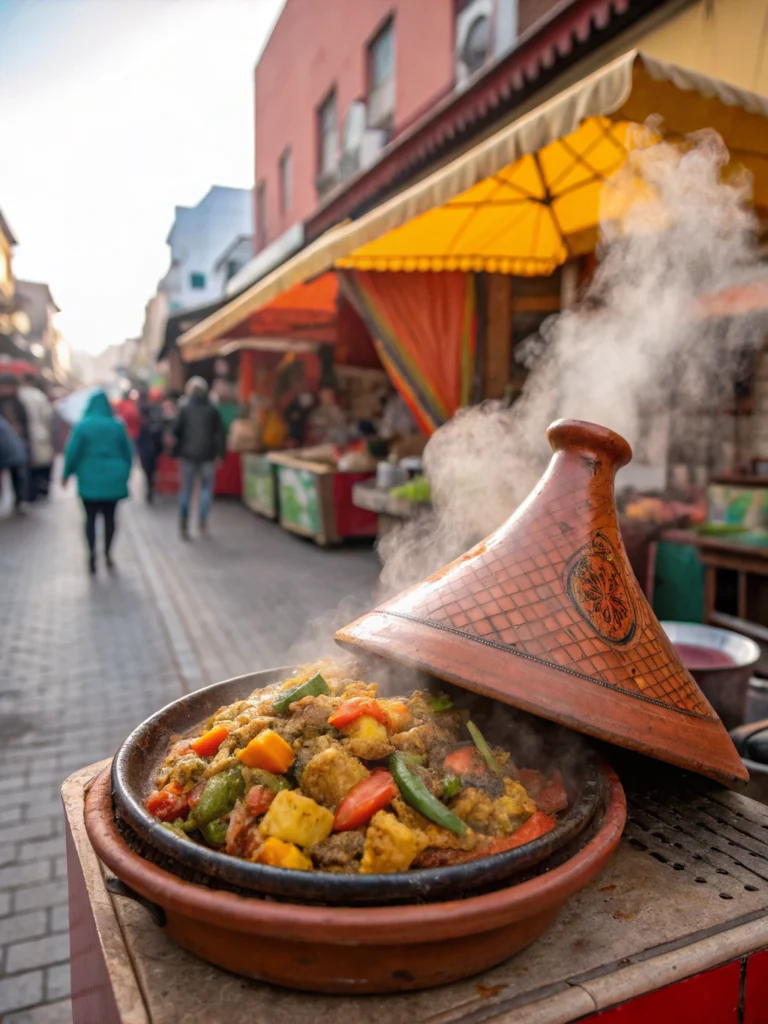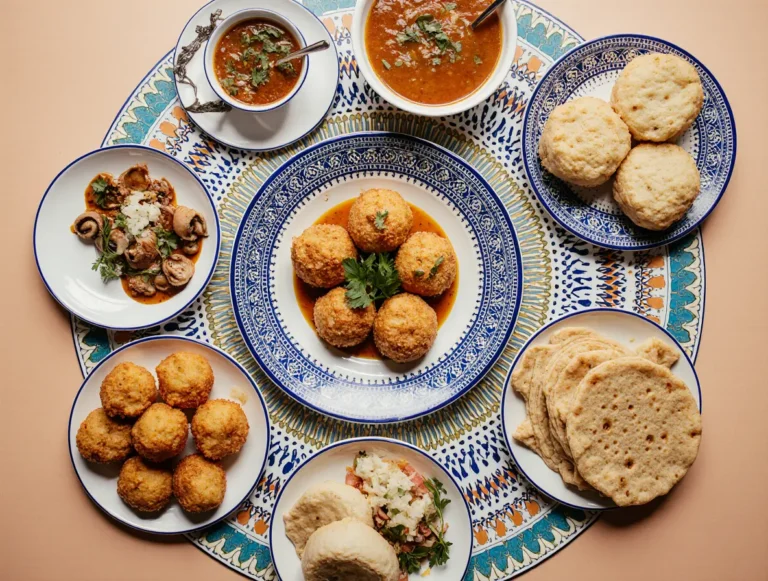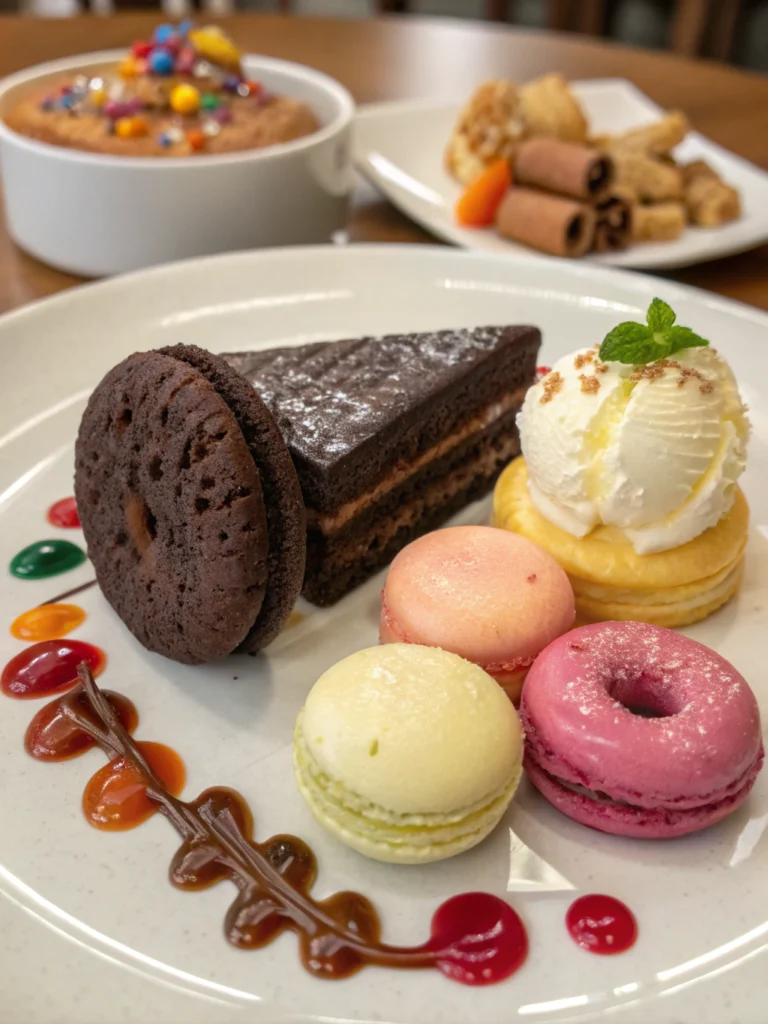Easy Moroccan Harira Soup to Warm You on Cold Nights

Winter’s chill is here, and nothing warms the soul like Moroccan harira soup. The scent of spices and hearty ingredients takes you to Marrakech’s bustling markets. There, this beloved soup has been a favorite for generations.
My grandmother would cook this soup for hours, filling our home with a mix of herbs, lentils, and meat. Every spoonful shares a story of tradition, comfort, and Moroccan hospitality.
This Moroccan harira soup recipe is more than a meal. It’s a journey to North Africa’s rich flavors in your kitchen. It’s perfect for cold nights or exploring authentic Moroccan cuisine. It will become your new comfort food.
Prepare to turn simple ingredients into a satisfying soup that nourishes body and spirit. Your kitchen will fill with the magical aromas of Moroccan tradition.
Introduction to Traditional Moroccan Harira Soup
Explore the world of Moroccan cuisine with harira, a legendary spiced broth. It’s more than a meal; it’s a cultural experience that connects generations. Its rich, complex flavors tell a story of tradition and warmth.
Harira is a nourishing dish in Moroccan cuisine, made with care. It combines tender legumes, aromatic spices, protein-rich ingredients, and fresh herbs. This blend creates a unique flavor profile.
The spiced broth is a canvas for creativity. Each family has its own harira recipe, passed down through generations. Some add lamb or chicken, while others stay vegetarian, showing the soup’s versatility.
Harira shows the depth of Moroccan culinary traditions. It’s not just about ingredients; it’s about connection, comfort, and the art of slow cooking. This transforms simple components into a soul-warming meal.
If you’re looking for comfort or want to try authentic Moroccan flavors, harira is a great choice. It offers a delicious journey into a rich cultural landscape.
The Cultural Significance of Harira in Moroccan Cuisine
Harira is a treasure in Moroccan cuisine, more than just a soup. It shows the rich culture and family bonds of Morocco. It combines flavors, memories, and generations of cooking skills.
The history of harira is deep in Moroccan cooking traditions. It shows the mix of cultures that shaped Moroccan food. This soup tells of strength, community, and shared moments.
Historical Origins and Traditional Serving Customs
Harira’s history is a journey through Moroccan past. It started as a meal for families, using affordable ingredients for deep flavors. Serving it shows its role as a shared dish:
- Served during family gatherings
- Prepared with love by elder family members
- Represents hospitality and warmth in Moroccan homes
Ramadan and Harira’s Special Place
In Ramadan, harira becomes a spiritual highlight. Families look forward to breaking their fast with it. It gives them the nutrients and comfort they need after fasting.
Regional Variations Across Morocco
Every region in Morocco makes harira its own way. This shows the variety of Moroccan food. From coast to mountains, the soup reflects local tastes and cooking methods, showing Morocco’s cultural richness.
Essential Ingredients for Authentic Moroccan Harira Soup
To make a true Moroccan lentil soup, you need the right ingredients. These ingredients add depth and richness to your soup. The secret to Harira is its mix of legumes, spices, and fresh produce.
Your essential ingredient list for this traditional soup includes:
- Dried chickpeas – the hearty base of your chickpea soup
- Green or brown lentils – providing protein and texture
- Lamb or beef (optional for meat version)
- Fresh tomatoes
- Onions and garlic
- Cilantro and parsley
Spices are key to making your lentil soup special. You’ll need ground cinnamon, turmeric, ginger, and the Moroccan spice blend ras el hanout. These spices make your soup warm and aromatic, just like Moroccan cuisine.
This soup is also very nutritious. Chickpeas and lentils are full of protein, fiber, and minerals. By adding fresh herbs and spices, you’re making a meal that’s good for you and connects you to Moroccan traditions.
Kitchen Tools and Equipment You’ll Need
Making a real slow-cooked stew like Moroccan Harira needs the right tools. The right equipment can really change how your soup tastes and feels. Whether you love cooking at home or are a pro, picking the right tools is key to a tasty meal.
If you love cooking the old way, you’ll need some special tools to make a true slow-cooked stew:
- Large clay pot or ceramic tagine
- Heavy-bottomed stockpot
- Wooden spoon for stirring
- Sharp chef’s knife
- Cutting board
Traditional Cooking Techniques
Moroccan cooking is all about slow, careful making. A clay pot or ceramic tagine spreads heat evenly, making flavors deeper. These old pots create a special cooking space that new gadgets can’t match.
Modern Kitchen Gadgets
Today’s kitchen tech makes cooking easier for those in a rush. An electric slow cooker or a multi-functional pressure cooker can make Harira prep quicker. These gadgets let you enjoy a traditional stew without spending hours cooking.
- Instant Pot
- Digital slow cooker
- Immersion blender
- Digital kitchen scale
No matter your cooking method, the main thing is to honor the old ways while fitting your kitchen and schedule.
Step-by-Step Preparation Method
Making authentic moroccan harira soup needs careful steps and the right ingredients. It’s all about precision in technique and choosing the best ingredients. Follow these steps to make a delicious meal that truly represents Moroccan cooking traditions.
- Prepare your ingredients: Gather fresh lamb or chicken, lentils, chickpeas, tomatoes, and classic Moroccan spices.
- Chop vegetables finely: Dice onions, celery, and cilantro with precision to ensure even cooking and flavor distribution.
- Brown the meat: Select high-quality protein and sear it to develop rich, deep flavors characteristic of traditional soup recipes.
- Build the soup base: Combine tomato paste, spices, and broth to create a robust foundation for your moroccan harira soup.
- Simmer slowly: Allow the soup to cook gradually, letting flavors meld and develop complexity.
The secret to a great harira is patience and knowing how flavors build up. Your aim is to make a soup that tells the story of Moroccan cooking, with each spoonful carrying the wisdom of generations.
Pro tip: Use a heavy-bottomed pot to prevent burning and ensure even heat distribution. Stir occasionally and taste as you go, adjusting spices to match your preference while maintaining the soup’s authentic character.
- Use fresh herbs for maximum flavor
- Allow sufficient time for ingredients to blend
- Adjust liquid consistency as needed
Your homemade moroccan harira soup will take you straight to Marrakech’s lively streets. It offers a warm and comforting dining experience that honors traditional Moroccan cuisine.
Mastering the Perfect Spice Blend
Making the perfect spice blend is key to a true Moroccan spiced broth. The right mix of spices turns a simple soup into a feast for your senses. It connects you to the rich history of Moroccan cooking.

Getting to know Moroccan spices takes time and practice. The secret to a great spiced broth is finding the right balance. This balance brings together different flavors in perfect harmony.
Traditional Spice Combinations
Your spice mix for Moroccan Harira soup usually has:
- Ground cinnamon
- Turmeric
- Ground ginger
- Paprika
- Cumin
Adjusting Flavors to Your Taste
Every cook has their own way of seasoning. Start with a little and taste as you add more. Remember, spices get stronger as they cook. So, it’s better to start with less to avoid overpowering the broth.
Storage Tips for Spice Blends
To keep your Moroccan spices fresh, store them in airtight containers. Keep them away from sunlight and heat. Glass jars with tight lids are best for keeping them fresh and preventing moisture.
- Store in cool, dark places
- Use within 3-6 months for maximum flavor
- Label containers with purchase or mixing dates
Vegetarian and Meat-Based Variations
Harira soup is great for everyone, whether you love meat or prefer plants. You can make it with lamb or as a vegetarian dish. It’s all about what you like and need.
Lamb soup is a favorite in Morocco. It’s full of tender lamb, adding protein and flavor. Choose good meat for the best taste.
Vegetarian harira is a tasty option for those who don’t eat meat. It’s packed with chickpeas, lentils, and veggies. Add spices like cumin and coriander for flavor.
- Chickpeas for protein
- Lentils for texture
- Fresh vegetables like celery and tomatoes
- Traditional spices including cumin and coriander
To make vegetarian harira, roast your veggies first. This brings out their sweetness. Use veggie broth for a rich base.
Both meat and veggie hariras are comforting. They’re all about the right spices and a thick, hearty soup. Stick to the traditional ways of making it.
Tips for Achieving Authentic Texture and Consistency
Making the perfect traditional soup takes patience and skill. The texture of your Moroccan Harira soup is key. It can make or break your meal. A slow-cooked stew needs attention to detail and understanding of cooking techniques.

Getting the right consistency is vital for authentic Harira. The soup should be thick but still pourable. It should have a smooth, hearty feel that shows its rich heritage.
Navigating Common Texture Challenges
- Prevent overly thick soup by gradually adding liquid during cooking
- Use a whisk to break down lentils and create smooth texture
- Let the soup rest for 10-15 minutes after cooking to allow natural thickening
Professional Chef’s Insider Techniques
- Start with room temperature ingredients for even cooking
- Stir frequently to prevent ingredient separation
- Use a heavy-bottomed pot for consistent heat distribution
Professional chefs say a traditional soup like Harira gets its complex flavors from careful prep. With these expert tips, your slow-cooked stew will turn into a culinary masterpiece.
Serving Suggestions and Traditional Accompaniments
Enjoying Harira, a classic Ramadan dish, is more than just eating. It’s about how you present it and what you serve with it. Traditional ways of serving make this hearty soup a true celebration of Moroccan cuisine.
Here are some tips to enjoy Harira like a true Moroccan:
- Serve hot in traditional ceramic bowls
- Garnish with fresh chopped cilantro or parsley
- Pair with warm, freshly baked Moroccan bread (khobz)
- Include a side of dates or sweet pastries
During Ramadan, Harira is a favorite evening meal. Families gather to break their fast with this nutritious soup. It’s served with sweet and savory sides, making it a special moment for everyone.
For a real Moroccan touch, add more spices on top and a squeeze of lemon. The lemon’s brightness balances the soup’s rich flavors. It makes the meal refreshing and captures the heart of Moroccan cuisine.
Make-Ahead and Storage Guidelines
Preparing your lentil or chickpea soup ahead of time can save you a lot of time during busy weekdays. Harira soup is especially good for make-ahead because it keeps its rich flavors well.
Storing your Harira soup right is key to keeping it tasty and safe. Here are some important tips to follow:
- Refrigeration: Store in airtight containers for up to 4-5 days
- Freezing: Can be frozen for 2-3 months without losing quality
- Separate liquid and solid ingredients when possible for best preservation
When you reheat your chickpea or lentil soup, use gentle heat. This helps keep the soup’s texture right. Stir it now and then and add a bit of water if it gets too thick. Microwaving is okay, but stovetop reheating gives you more control.
Pro tip: If you’re freezing your Harira, store the base and garnishes separately. This keeps the soup’s flavor and texture better.
- Always cool soup completely before storing
- Use clean, sealed containers
- Label containers with date of preparation
By following these storage tips, your Harira soup will stay as tasty as when you first made it. It’ll be ready to warm you up whenever you need it.
Conclusion
Exploring Moroccan harira soup is more than just a recipe. It’s a journey into Moroccan culture, connecting families through its rich flavors. Your kitchen can be a doorway to North African cuisine.
Making this soup at home is more than just cooking. It’s about sharing stories of family and Ramadan. You can also make it your own, fitting it to your taste and diet.
Whether you’re an experienced cook or just starting, this recipe is an invitation to explore. Share your harira soup with loved ones, making new memories. Your version could become a favorite in your home.
We encourage you to dive into the warmth and flavors of this traditional soup. Your culinary journey begins now. Get your ingredients ready and start cooking Moroccan magic!
